North Korean COVID-19/Fever Data Tracker
Article last updated on August 15, 2022.
After two years of claiming no confirmed COVID-19 cases, North Korea disclosed a nationwide outbreak on May 13 and launched emergency epidemic prevention measures. The epidemic began in late April.
Officially, only a handful of cases have been confirmed as COVID-19, with the rest attributed to an unidentified “fever.” This is likely due to insufficient testing capabilities, and many are assumed to be COVID-19 related, however, that might not be the entire picture. North Korean state media has been publishing daily data on the outbreak, which is featured below. 38 North will update these numbers daily as new information becomes available.
Current Situation
The last nation to declare a COVID-19 outbreak has already declared it over. North Korea stood down its emergency anti-epidemic system and declared victory over COVID-19, state media said on Saturday.
That means mandatory mask wearing has ended across the country except in areas very close to the country’s northern and southern borders. Life for many citizens should begin returning to normal and travel restrictions related to the epidemic have also been lifted.
The declaration comes almost three months to the day since North Korea first acknowledged a COVID-19 outbreak. It is said to have started in late April and, according to government figures, went on to hit 18.5 percent of the population. State media said 4.7 million people experienced fevers during the outbreak, although how many were due to COVID-19 is unclear. North Korea lacks large scale testing facilities.
The official death toll stands at just 74 although there are reasons to question these figures. Not only did fatalities lead cases rather than follow them, but the state never disclosed how it classified cases or how the data was collected.
Nevertheless, the emergency period is officially over and on Monday, state TV showed maskless Pyongyang residents laying flowers on Mansudae Hill to mark the anniversary of the country’s liberation from Japan in 1945.
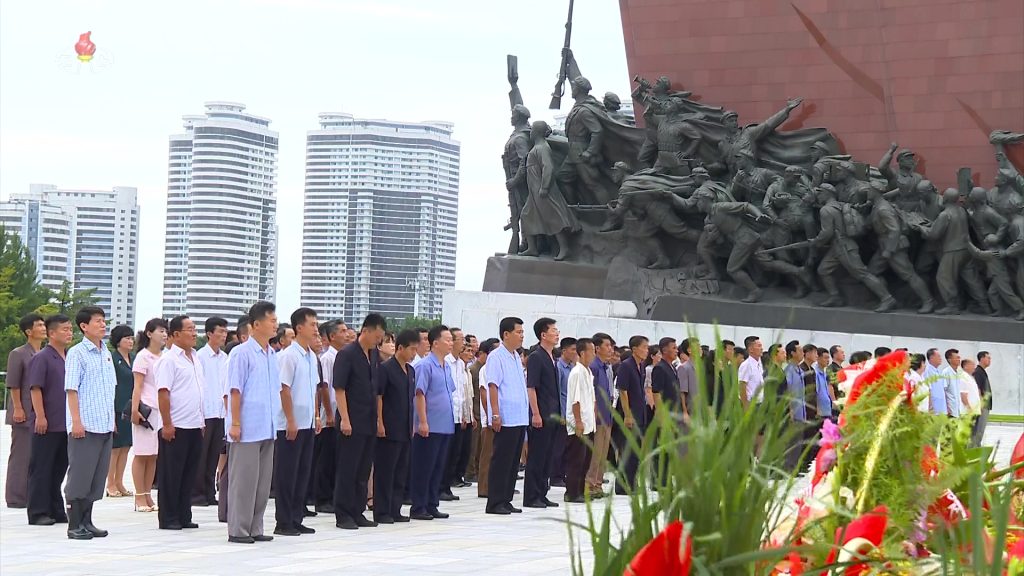
As part of the standdown of emergency measures, military medics who had been dispatched to aid health workers returned to their units, state media reported on Monday.
Even before the COVID-19 epidemic was acknowledged by state media, independent reports from the country indicated the virus was spreading. Several outbreaks had been reported by the Seoul-based DailyNK, which gathers information from people inside the country. It will be worth watching the site to see if further outbreaks are reported that differ from the official news bulletins.
With the end of the emergency period and no further data expected from the North Korean government, this is the final entry in the 38 North COVID-19 Tracker.
Provincial Data
Previous Updates
August 8, 2022
Sunday marked the tenth day since North Korea last reported a new Covid-19 case and the fifth day of the country being completely Covid-19 free—at least according to government statistics. However, the data collection process has always been opaque; it has never been clear exactly how the state defines a fever, how testing is done, or if testing is done at all.
That said, on Friday, six fever cases were detected in North Pyongan and South Hamgyong provinces. State media reported on Sunday reported that there had been six fever cases detected in North Pyongan and South Hamgyong provinces but that “rapid mobile anti-epidemic teams” were sent to each province to do PCR testing. The cases turned out to be non-Covid related fevers, preserving the state’s claim to be Covid-19 free, at least for now.
On Monday, state media reported that a national meeting is due to be convened in the next few days to review the successes and lessons from the anti-epidemic work carried out so far.
August 4
North Korea reported five people recovered from Covid-19/fever on Wednesday to leave the country with no current cases – at least according to the state figures. Since soon after the country declared an outbreak in mid May, the number of cases has trended downwards and on Wednesday, finally reached zero. The announcement was made with little fanfare and the emergency anti-epidemic regulations look set to continue despite the apparent lack of cases.
Little is known about how North Korea collects this data and even classifies and confirms cases, so the actual situation in the country is unclear. Simply based on the global experience, it is almost certain that cases still exist in the country so the continuation of emergency protocols is likely necessary.
At its peak the country had 754,810 current cases on May 19. Over the course of the outbreak, 4.7 million people or 18.5 percent of the population have experienced fever, according to the government figures. There have been only 74 fatalities, according to the state.
August 3
The spread of Covid-19/fever in North Korea is in the “terminal stage,” state media said Wednesday as it reported just five current cases nationwide. That’s a major drop from 95 cases the day before and sets the stage for the country to reach zero cases in the coming days, possibly as early as Thursday.
Wednesday was the fifth day in a row with no new cases registered.
Several regions of the country, including Pyongyang, had previously reported zero current cases. The location of the current five is unknown as North Korea has not provided regional figures for several days.
However, little is known about the country’s data collection methods so it’s unclear how reliable the figures are.
The state said it is responding by intensifying education and control of citizens to prevent them from loosening their vigilance against the epidemic.
August 1, 2022
For the first time since North Korea declared an epidemic emergency in mid May, the country has reported no new cases of COVID-19/fever. State media said on Saturday, Sunday and Monday that no additional cases were detected the prior day. As of late Sunday, the country had just 204 cases nationwide, according to the data.
Much is uncertain about North Korea’s data collection methods and capabilities, so the accuracy of the figures is unclear, but whether true or not the figures are what the state is presenting to the North Korean public. State television images from around the country indicate that mask wearing continues to be practiced and social distancing is still being used at some events.
Over the weekend, state media reported more than 300,000 anti-epidemic and hygiene workers are now involved in a push to keep case numbers at zero. On Saturday, state TV broadcast images of a new lab established by the State Academy of Sciences to test for viruses. The report was not specifically about COVID-19, but in recent weeks media has spoken of new labs to help accurately detect cases.
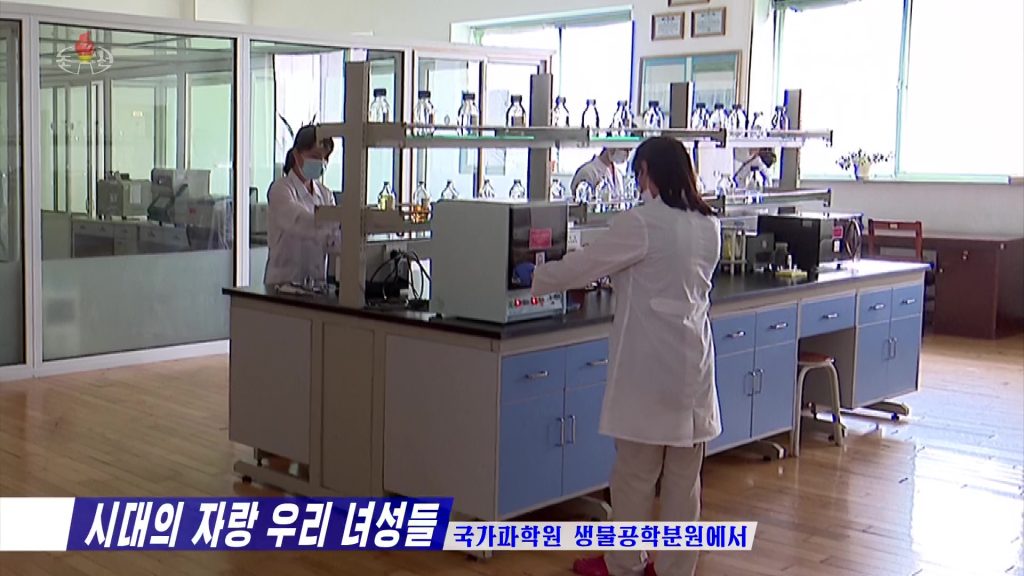
July 27, 2022
North Korea’s capital city is finally COVID-19/fever free according to official government data. Figures broadcast on Korean Central Television on Wednesday said Pyongyang was one of seven regions to have no current cases as of 6 p.m. on July 26. The accomplishment is a major step for the country, which began battling the outbreak in late April this year. At its peak in mid May, Pyongyang was reported to have 269,063 people under treatment.
Across the country, North Phyongan, South Phyongan, North Hwanghae, and Ryanggang provinces, along with the cities of Nampho and Kaesong also reported no current cases (people in treatment) as of Tuesday.
The vast majority of North Korea’s current cases are centered on Kangwon province, where 140 people were in treatment on July 26. However, no new cases were reported there that day, suggesting this number may drop quickly.
The second highest number of cases under treatment were in South Hwanghae province at 43. South Hamgyong province had 17 cases and there were 10 in Jagang province. Rason and South Hamgyong province reported a single case under treatment.
Looks That said, most provinces across the country reported no new cases on July 26, with the exception of South Hamgyong province, which had three.
On Tuesday, the 8th National Conference of War Veterans took place in Pyongyang and images from the Korean Central News Agency showed few to no attendees wearing masks. In other TV footage of events in Pyongyang, people are seen wearing masks.
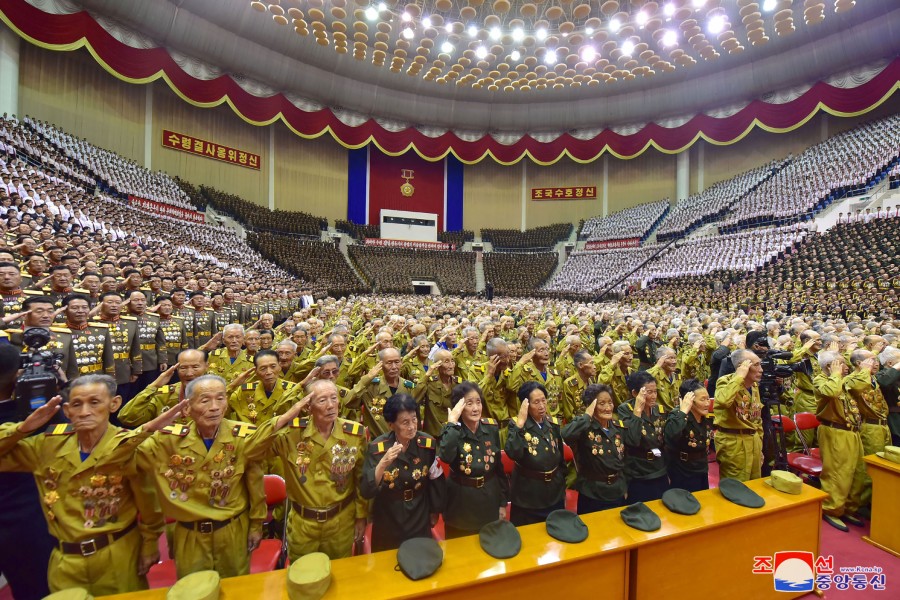
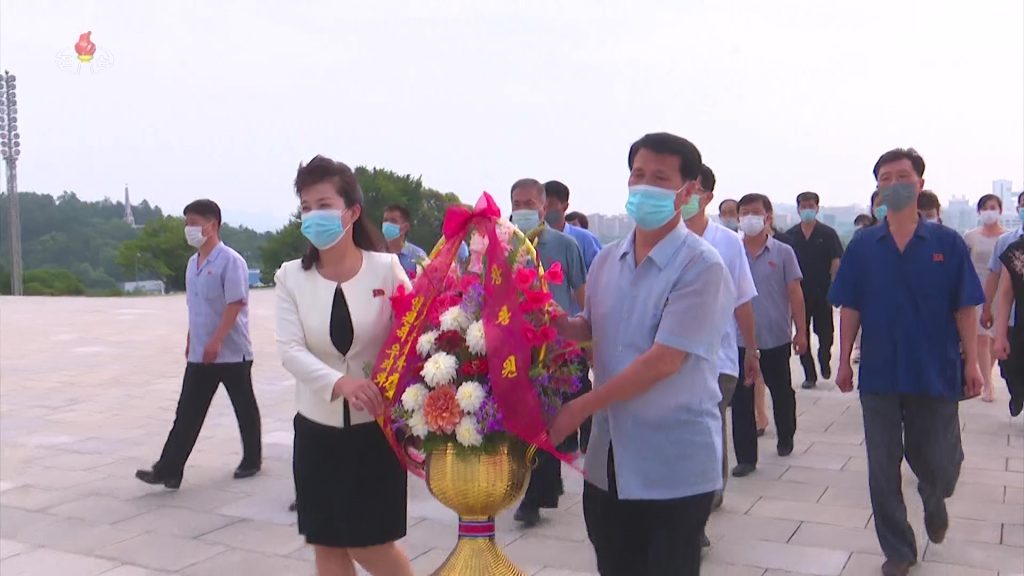
July 25, 2022
The COVID-19/fever situation in North Korea appears to be largely driven by an outbreak in Kangwon Province, which accounts for roughly half of the 330 cases reported on July 24, according to state data. The country saw 50 new cases and 80 recoveries on Sunday, the second day in a row where recoveries outpaced cases. North Korea had been on a long trend toward zero until Friday when the total number of cases rose for the first time since May 29. On Sunday, case numbers began to decline again.
The outbreak in Kangwon province continued to grow over the weekend. On Saturday there were 170 cases in the province, up from 145 cases the day before. Cases have been rising for four days since hitting a low of 88 cases on May 19.
North Phyongan, Ryanggang, Nampho and Kaesong provinces all reported zero cases and several other provinces are close to zero. In Pyongyang there were just 3 active cases, 2 in North Hamgyong province and 1 in North Hwanghae province. Six provinces reported no new cases on Saturday.
July 18, 2022
The number of active COVID-19/fever cases in North Korea dropped to just 710 on Sunday, according to government figures, but the onset of the new BA.2.75 subvariant of COVID will likely mean the country’s emergency anti-epidemic measures continue for some time.
Over the weekend, state media said the emergence of the subvariant “calls for strengthening the anti-epidemic work.” It also said a guide has been drawn up “for collecting and delivering samples of monkeypox virus” and for its treatment. The country has yet to report any instances of monkeypox.
On Sunday the country counted 310 new cases of COVID-19/fever. In total, 4.8 million North Koreans were affected at some point during the outbreak.
Nampho and Kaesong continue to be COVID-19/fever free and Rason is just three cases away from the same milestone, according to state figures. On Saturday, Rason reported no new cases for the first time, leaving just the three people currently under treatment.
Jagang and South Hwanghae provinces are counting single-digit numbers of cases at eight and nine respectively, while there are 69 cases in Pyongyang.
South Phyongan province continues to report the greatest number of cases at 248, according to the data.
July 15, 2022
North Korea registered 500 new cases of COVID-19/fever on Thursday and the number of current cases nationwide fell to 1,120, according to state media. In the last week, the number of cases has fallen by more than 60 percent and it appears the epidemic is in its final days and weeks, assuming there isn’t a fresh outbreak.
The total number of people that have experienced symptoms stands at 4.8 million, or 18.5 percent of the population.
Both Nampho and Kaesong continue to report zero new or current cases. In Pyongyang, there were 76 people under treatment as of 6 p.m. on July 13 and levels are in the double digits in many other provinces and cities. The highest number remains in South Phyongan province where 392 were under treatment as of Wednesday evening.
July 11, 2022
Two North Korean regions have reported no cases of COVID-19/fever for the first time since the government began providing epidemic data in mid May. Cases in Nampo and Kaesong hit zero on Saturday, July 9, according to figures broadcast on Korean Central Television on Sunday.
Both regions had once been among the worst affected by the outbreak but hit zero cases as numbers have consistently dropped nationwide since the end of May.
There were 1,280 new cases reported nationwide on Sunday and the total number of people under treatment at 6 p.m. was 2,280.
In addition to Nampo and Kaesong reporting zero cases, Rason reported just 6 cases, there were 15 in North Hamgyong, 18 in Ryanggang, and 25 in Jagang provinces as of 6 p.m. on Saturday. In Pyongyang, there were 127 cases, which is about 10 percent of the national caseload.
While case numbers continue their overall downward trend nationwide, there were two blips in the data over the weekend. In South Phyongan province the number of current cases jumped from 673 on Friday to 695 on Saturday and in Kangwon provinces cases rose to 250 from 213 the day before.
It’s too early to tell if this is the significant start of a new upward trend or a single daily jump. Little is known about North Korea’s data collection methods and the reliability of the data on a day-to-day basis.
July 8, 2022
North Korea recorded an additional 1,630 cases of COVID-19/fever on Thursday, according to state media. The figure represented a new low and continues a more-than month-long decline in the number of new cases. Overall, there were 3,110 people under treatment for COVID-19/fever on Thursday, according to the government’s figures.
Yesterday, we noted the lack of masks at a major political meeting in Pyongyang that took place earlier in the week. Thousands of delegates were shown on state television packed into a hall and no one was wearing a mask. In contrast, state TV on Friday broadcast images of meetings in provincial towns and cities where the people wore masks even at outdoor events. This suggests some form of testing may have been used to clear attendees to the Pyongyang meeting.
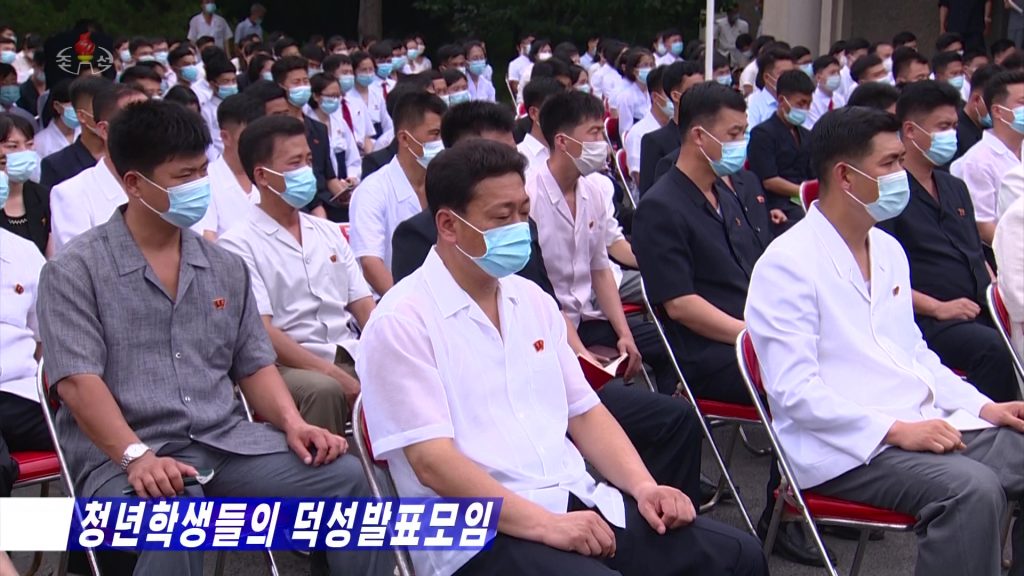
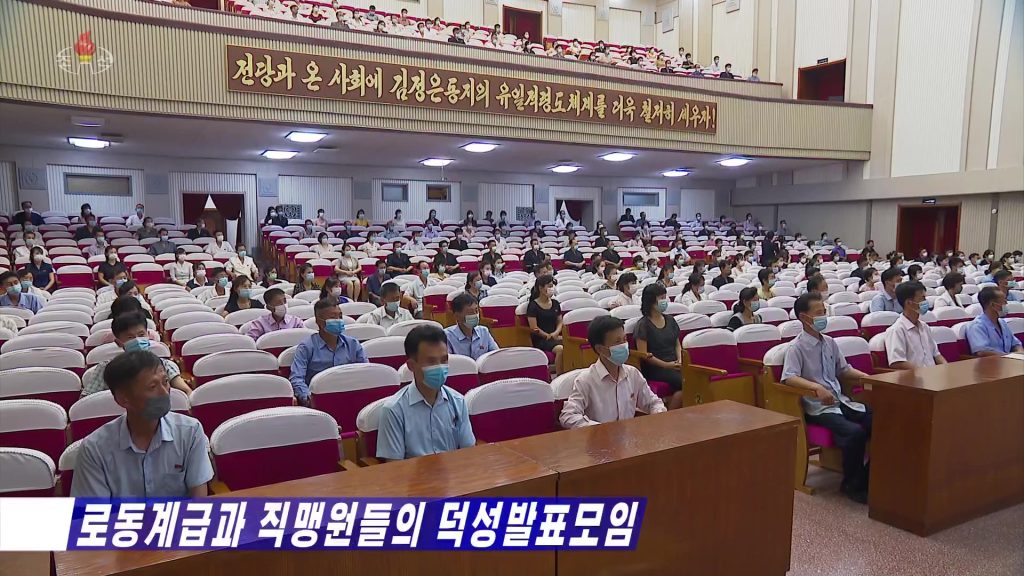
State TV provided province-by-province data for the first time in several days. Early on in the epidemic, such data was presented on a daily basis but the frequency has dropped in the last couple of weeks as the epidemic has waned.
On Thursday, 172 people were under treatment in Pyongyang, with and 67 new cases in the capital. South Pyongan province was reported to have the most people under treatment with 723 in treatment; Rason had the lowest number of cases, with just 12 people under treatment.
July 7, 2022
North Korea appears increasingly confident that its COVID-19/fever epidemic is well under control. On Thursday, state media published photos of a large political meeting in Pyongyang that brought together thousands of party committee delegates and included a speech by Kim Jong Un—and there didn’t appear to be a mask in the house.
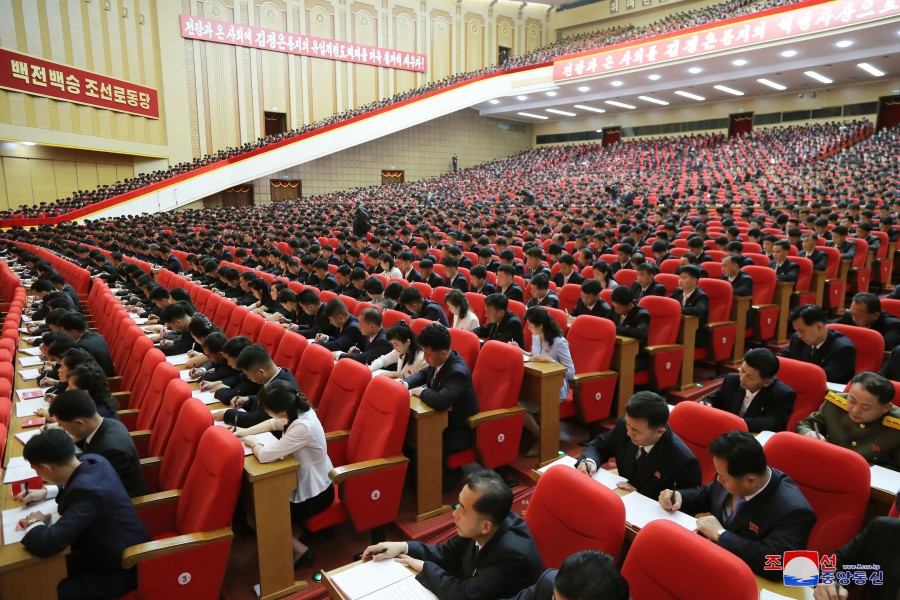
The maskless meeting came on a day the state reported an additional 1,950 cases of fever nationwide. There were 3,550 people under treatment across the nation, which is an all-time low since media began reporting data in May.
While those at the Pyongyang meeting were without masks, ordinary citizens appear to still be wearing them each day. Recent TV images of citizens coping with the sweltering heat in Pyongyang showed widespread masking in public outdoors
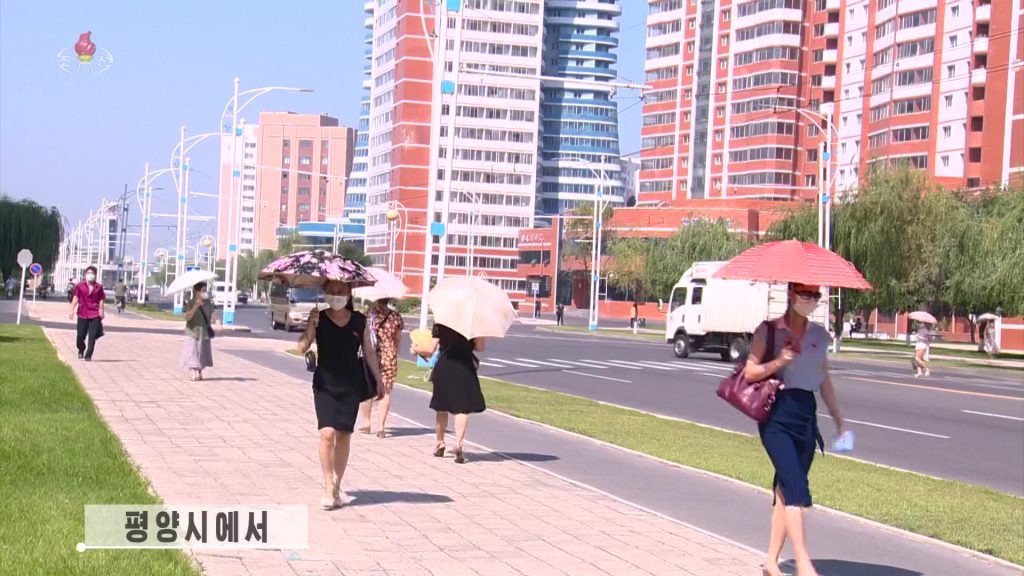
July 6, 2022
North Korea reported its first death in almost three weeks on Wednesday as the COVID-19/fever epidemic continues to wane, according to official figures. The fatality takes the total number of deaths to just 74 in an outbreak that has sickened 4.8 million people.
On Wednesday, an additional 2,140 new cases were reported, but recoveries continue to outpace new cases. The total number of cases nationwide was just 4,000, according to the official data.
Total cases have been dropping by around 13 percent per day for the last couple of weeks and could soon be into the triple digits if the trend continues. In comparison, a month ago on June 6, there were 115,240 cases in treatment.
Provincial totals as of 6 p.m. on July 2 show continued decline in each province.
July 1, 2022
Data reports from state media note further decline in new fever cases. In the 24 hours to 6 p.m. on June 29, 4,570 additional cases were counted, a three percent drop from the day prior. New recoveries totaled 5,690. This brings the total cases reported to 4,744,430 with 4,736,220 total counted recoveries.
State media reported that the source of COVID-19 cases has been identified. In Ipho-ri, part of Kumgang County north of the South Korean border, it was reported an 18-year-old soldier and 5-year-old "contacted with alien things" in early April. The article also issued instruction to "vigilantly deal" with unknown objects "coming by wind and other climate phenomena and balloons," namely around the border.
June 29, 2022
Data reports from state media note further decline in new fever cases. In the 24 hours to 6 p.m. on June 29, 4,730 additional cases were counted, down 21 percent from the previous day, the biggest decline since May 16. New recoveries totaled 6,720. This brings the total cases reported to 4,739,860 with 4,730,530 total counted recoveries.
June 28, 2022
Data reports from state media note further decline in new fever cases. In the 24 hours to 6 p.m. on June 28, 5,980 additional cases were counted, down 11 percent from the previous day. New recoveries totaled . This brings the total cases reported to 4,735,120 with 4,723,810 total recoveries.
June 27, 2022
Data reports from state media note further decline in new fever cases. In the 24 hours to 6 p.m. on June 26, 7,300 additional cases were counted. At 18 percent, this was the largest reported decline. New recoveries dropped 14 percent, with 9,090 cases. This brings the total cases reported to 4,722,430, with 4,708,510 total recoveries.
Provincial totals as of 6 p.m. on June 24 show continued decline in each province, consistent with overall trends.
June 24, 2022
Data reports from state media note further decline in new fever cases. In the 24 hours to 6 p.m. on June 23, 11,010 additional cases were counted. At 16 percent, this was the largest reported decline since May 23. New recoveries dropped 18 percent, with 13,890 cases. This brings the total cases reported to 4,696,580, with4,676,760 total recoveries.
In a recent piece for 38 North, Martyn Williams discusses the data trends and how they compare to global standards. Of particular note, has been the incredibly low number of reported deaths—only 73 since June 16—well below global average COVID-19 death rates.
Provincial totals as of 6 p.m. on June 23 show continued decline in each province, consistent with overall trends. The percent of population with reported fever cases is highest in Rason and South Hwanghae Province, though at 0.19 percent and 0.17 percent respectively are not indicative of a high concentration of number of cases.
June 22, 2022
Consistent with the recent trend, the number of newly reported fever cases continues to decline. Based on figures reported in the 24 hours to 6 p.m. on June 21, there has been a 12 percent decline in new cases, a greater drop than the past three days. New cases totaled 15,260, alongside 18,540 new recoveries. In addition, 26,000 people were reported under treatment, bringing the cumulative total number of cases to 4,672,450.
No new deaths have been reported since June 11, maintaining the number of reported deaths at 72.
Provincial totals as of 6 p.m. on June 19 show a declining number of cases in each province. The largest percent change was reported in North Hamgyong province, with a 40 percent decline in cases from June 17 to June 19.
June 19, 2022
The fever epidemic continued its decline over the weekend but numbers of new cases and recovered slowed. In the 24 hours to 6 p.m. on June 19, North Korea counted 18,820 new cases of fever and 21,060 recoveries. In the last few days, those totals had been dropping by about 11 percent a day, but the latest figures represent a drop of just three percent and four percent, respectively.
As of 6 p.m. on Sunday, the country had 31,540 total active cases, according to the latest state data. Since the epidemic began in late April, 4.6 million people have been treated. That’s equivalent to 18 percent of the population, but the number of deaths is just 72.
On Monday, state media reported that “a scientific and realistic plan” had been adopted for “restoring the anti-epidemic stability.” The report hints at problems but did not disclose what had happened to necessitate the need to “restore stability.”
Across the nation, a single province registered a rise in the number of active cases in the 24 hours to 6 p.m. on Saturday. Kangwon Province saw cases rise from 2,112 to 2,140. Driving the rise was a jump in the number of new cases in the province from 1,313 to 1,384. The number of new cases also rose in Nampho.
As the overall number of cases drops into the low thousands and triple digits nationwide, smaller outbreaks have the potential to push overall case numbers higher. This is perhaps a period of greater instability in case numbers and the reason why state media highlighted the need to restore stability to the anti-epidemic push.
June 16, 2022
The total number of cases fever cases continued to drop in North Korea on Wednesday, but the country reported its first death in four days and an increase in the number of newly diagnosed cases in two regions.
As of 6 p.m. on Wednesday, 46,230 people were being treated in relation to the epidemic in North Korea, down 12 percent on the day. An additional 26,010 cases were identified on Wednesday, down 13 percent on the day before.
A single death was reported in Pyongyang to bring the total number of fatalities to 73 people. In total, 4.5 million people have been sickened and recovered, according to state media.
The total number of cases fell in every region of the country but the number of newly diagnosed cased rose slightly in Rason and Kaesong. The rises are minor—from 163 to 154 in Rason and from 437 to 457 in Kaesong—so it’s too early to tell if this is the beginning of a trend.
June 15, 2022
North Korea recorded 29,910 new cases of fever in the 24 hours to 6 p.m. on Tuesday, a drop of 9 percent on the prior day. There were 35,380 recoveries, down 12 percent, to leave the total number of current cases at 52,310. That figure has dropped for the last 16 days and is on target to fall under 50,000 on Wednesday.
In total, 4.53 million cases have been counted across the nation, accounting for 17.6 percent of the country’s population.
Every province and city saw a drop in the number of current cases on Tuesday.
In Pyongyang, the number of current cases dropped from 1,904 to 1,696, which is equivalent to 0.05 percent of the city’s population. Pyongyang now has the lowest incidence of current cases of any region across North Korea.
The highest rate of cases is in North Pyongan at 0.42 percent of the province’s population, although while highest it is substantially lower that levels recorded a couple of weeks ago. On Tuesday there were 12,852 cases in the province.
The number of newly diagnosed cases dropped in all provinces and cities with the exception of Rason, where they rose from 157 to 163 cases. It’s the second time in a week that the number of new cases has risen in Rason, although the increases have been small each time. Rason has had one of the highest rates of cases through the epidemic and on Tuesday it counted 695 total cases, equivalent to 0.32 percent of the population.
June 12, 2022
North Korea authorities announced a new fever death over the weekend to take the total in the epidemic to 72 – a remarkably low death toll for an outbreak that has hit almost 4.5 million people in the country. As of 6 p.m. on Sunday, there were 65,230 people under treatment, according to the announcement.
An additional 35,710 new cases were reported in the 24 hours to 6 p.m. on Sunday with 42,650 recovering, according to the state data. Both numbers have been trending downward for over a week. Today, we add a new graph that charts the number of new cases and recoveries. The graph shows that the two numbers are slowly getting closer together. If the lines cross, it will signify the outbreak is growing again.
On Monday, state media ran an article that praised Kim Jong Un and the Workers’ Party of Korea for their swift handling of the epidemic and for bringing it under control so quickly. The Korean Central News Agency carried 39 images that showed Kim and other scenes from the past month’s efforts to bring the outbreak under control. Similar content is running on state television as media begins to turn the outbreak into a propaganda tool.
June 11, 2022
North Korea’s battle against the epidemic showed signs of slowing on Saturday with small rises in the number of new cases in several provinces and a warning from the state against passive and lax attitudes towards the epidemic.
The country registered 42,810 new cases on Friday, which was a drop of 2,730 on the day before. It was the smallest daily drop for a week.
State media said Saturday that the government was “taking timely measures to make officials and working people guard against passive attitude and laxity” and urged “everyone to abide by the existing discipline and order.”
It specifically called on people to police one another so that “no-one would contact alien things or wild animals along the areas of the border, coasts and frontline.”
Across the nation, 77,150 people were under treatment on Friday while 4.3 million have recovered. The epidemic has hit 4.4 million people or 17 percent of the population. The death toll remains at 71 with no new deaths reported for a week.
While the number of new cases declined overall, they rose in Rason and Kaesong and were unchanged in North Hamgyong province. The rise in new cases is small, so it’s too early to tell if this is the beginning of new spread or a data anomaly.
The total number of people under treatment declined in each province and city.
June 10, 2022
North Korea continues to be winning the battle against a fever epidemic, according to state data. On Thursday, there were 83,980 people being treated, a drop of 10,000 on the day. This was also the sixth straight day with no reported deaths.
The data is impossible to verify but does represent how the North Korean government is presenting the story of COVID-19 to its people: that the outbreak is under control and abating.
But, while the total number of cases continues to fall, new cases are reported each day. In the 24 hours to 6 p.m. on Thursday, the nation saw 45,540 new cases of “fever.” The number of new cases has been falling at about 5,000 per day for the last week. In total, 4.3 million people, or just under 17 percent of the population have experienced sickness as a result of the epidemic, and the death toll stands at 71.
On Friday, state media reported that public health authorities are working to enhance the “scientific accuracy, promptness and credibility of medical checkups, tests and treatment.” The need to enhance those three areas suggests that some problems have been experienced in the last few weeks. On Wednesday, Daily NK reported that North Koreans are skeptical of the government provided numbers and response.
Cases are falling in all cities and provinces across North Korea. In Pyongyang, cases stood at 3,094 as of 6 p.m. on Thursday, which is one tenth of one percent of the city’s population.
North Pyongan province in Rason each recorded the highest number of cases, although it amounted to just 0.6 percent of the population of each area. The number of new cases dropped across the country; although in Kaesong they declined only slightly from 712 to 700.
June 9, 2022
North Korea’s battle against Covid hit two milestones on Wednesday, according to government data. For the first time since data began being published on May 12, the total number of current cases dropped below 100,000, and the country marked its fifth straight day with no deaths, which is a record.
As of 6 p.m. on Wednesday, 93,690 people were being treated for “fever,” according to the government. There were 50,890 new cases reported, which is a fall from 54,610 the previous day. New cases have been falling for seven straight days. In total, 4.3 million people have experienced fever, and the death toll stands at 71 people, according to the government.
June 8, 2022
Cases of fever fell again in North Korea on Tuesday as the country is a day away from a new milestone, according to state figures. At its current trajectory, the total number of active cases is expected to drop below 100,000 on Wednesday for the first time since data began being provided in mid-May.
On Tuesday, there were 103,300 cases of fever nationwide, down from 115,240 a day earlier. An additional 54,610 people were sickened on Tuesday and 66,520 recovered, according to the government.
In Pyongyang on Tuesday, a meeting of the politburo was held. Kim Jong Un wasn’t in attendance, and a single photo released by state media showed the majority of the members present were not wearing masks. The number of active cases in Pyongyang has dropped substantially in the last couple of weeks, and the city has come out of a lockdown.
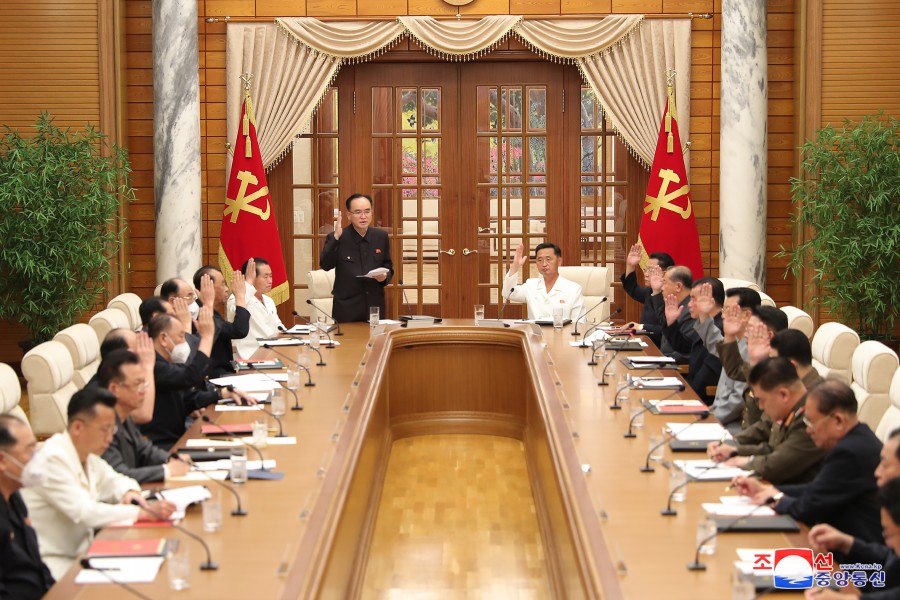
The number of cases under treatment declined in every province with the exception of South Hwanghae province where, in the 24 hours to 6 p.m. on June 5, there were 14,484 people currently being treated, up just over 100 on the previous day. That’s 0.5 percent of the province’s population.
The hotspot continues to be Rason where 2,503 people were reported sick, or roughly 1.1 percent of the population. While that is the highest number nationwide, it’s well below figures reported in several provinces in mid-May.
In North Pyongan province, just under one percent of the population or 28,402 people are currently under treatment. That’s down slightly from 29,887 people the day earlier. In contrast, there are 5,877 people being treated in Pyongyang.
June 7, 2022
The slow decline in fever cases continued nationwide on June 6 with 115,240 people currently under treatment, down 10 percent on the day, according to government reporting. The number of people newly diagnosed was 61,730, which declined on the previous day for the fifth straight day.
Across the country, 4.2 million citizens have been reported with feverish symptoms (presumably COVID-19 related), which represents 16 percent of the population. There were no additional deaths reported, and the number of total fatalities stands at 71 people.
The number of cases under treatment declined in every province with the exception of South Hwanghae province where, in the 24 hours to 6 p.m. on June 5, there were 14,484 people currently being treated, up just over 100 on the previous day. That’s 0.5 percent of the province’s population.
The hotspot continues to be Rason where 2,503 people were reported sick, or roughly 1.1 percent of the population. While that is the highest number nationwide, it’s well below figures reported in several provinces in mid-May.
In North Pyongan province, just under one percent of the population or 28,402 people are currently under treatment. That’s down slightly from 29,887 people the day earlier. In contrast, there are 5,877 people being treated in Pyongyang.
June 6, 2022
The North Korean government continues to report a decreasing number of new cases of fever each day. On Monday, it said 66,680 people had been reported ill in the 24 hours to 6 p.m. on June 5, versus 73,780 and 79,100 the previous two days.
A single additional death was reported over the weekend to take the total number of fatalities to 71 people. That death occurred in Pyongyang.
Overall, 4.1 million people had feverish symptoms (presumably COVID-19 related), and 127,620 people remain under treatment, according to the government figures. The total number of people being treated has fallen for the last seven days.
Most regions of the country are seeing lower levels of new cases and patients under treatment, but the situation isn’t equal across every city and province. The concentration on Pyongyang in epidemic work is showing in state data as the capital city, which once had the largest number of patients being treated, continues to see the number of cases fall faster than other regions.
In Pyongyang, 6,614 people were being treated as of 6 p.m. on June 4, according to official figures. That’s equivalent to 0.2 percent of the city’s population.
In North Pyongan and South Pyongan provinces, the number stood at 29,887 and 20,747 people respectively, the two largest in the nation. North Hwanghae and South Hwanghae provinces saw only small decreases in the number of people being treated, and the number rose slightly in Kangwon.
June 3, 2022
The number of new cases fell in the 24 hours to 6 p.m. on Thursday, down 15 percent to 82,160, according to the government figures. The drop follows a jump the previous day and is the lowest number of new cases registered since figures began declining in mid May.
Across the nation, the number of people currently reported with fever is 153,720, down 7 percent from the previous day. In total, 3.9 million people have experienced fever since the outbreak began in late April. That’s equivalent to 15 percent of the population. The death toll stands at 70 people and Thursday was the fourth straight day of no deaths being reported, which is the longest stretch yet recorded.
Active cases rose in Rason on Thursday to 2,717 people, equivalent to 1.2 percent of the province’s population. Rason has the highest percentage of sick citizens at present, although the numbers are well down from where they were two weeks ago.
Cases also rose in South Hwanghae, Jagang and North Hamgyong provinces. The recent jumps in cases in North and South Pyongan provinces and North Hwanghae appears to have reversed.
In Pyongyang, the number of active cases has fallen below 10,000 for the first time since the state began providing data in mid May. On Thursday it stood at 8,548 people or 0.2 percent of the city’s population.
June 2, 2022
As the epidemic comes under control in Pyongyang, authorities are battling rising numbers of cases in regions outside the capital, and that’s slowing the overall rate of decline, according to the latest government figures.
In the 24 hours to 6 p.m. on June 1, an additional 96,910 new cases of fever were reported, which is up four percent on the day earlier. New cases have been bouncing between 100,000 and 88,000 for the last week as regional outbreaks affect the progress made in cities.
However, as the number of new cases rises, so does the reported number of recoveries. It was 108,990 on June 1. As a result, the overall number of current cases was 165,390, which is down seven percent on the day.
In total, 3.8 million North Koreans have experienced fever, equivalent to 15 percent of the population.
On Thursday, the World Health Organization said that despite the data, it assumed the situation was getting worse, not better, but its evaluation is hampered by a lack of raw data. “We’re working off the same information that most of you are,” said Mike Ryan, the WHO’s executive director of health emergencies. “We have real issues in getting access to the raw data and to the actual situation on the ground.”
The number of people under treatment in Pyongyang continued to fall to 10,392 in the 24 hours to 6 p.m. on June 1, which is about a third of the number of a week ago.
However, the situation in some provinces is not as good. Total cases have fallen in North Pyongan province in the last couple of days but are still more than double the number a week ago. South Hwanghae and Jagang provinces are also experiencing a reversal in recent declines.
Perhaps as a result of the rising cases outside of Pyongyang, state media reported on Thursday that all provinces have intensified their anti-epidemic work. It said each province's mass disinfection of workplaces and dwellings is happening each day, and more than 1,800 epidemic prevention posts have been established. The report said authorities are conducting body temperature measurement and disinfection of travelers.
June 1, 2022
The number of new cases of fever dropped for the second day in a row after two days of rises at the weekend, according to government figures. A total of 93,180 people were newly ill on Tuesday, down from 96,020 the day before and 100,710 on Sunday. Recoveries continued to decline alongside the falling number of new cases, and no deaths were reported by state media on Tuesday.
The number of new cases has bounced in a range from 100,000 to 88,000 over the last six days. At present, 3.7 million North Koreans have been reported with feverish symptoms (presumably COVID-19 related), and this seems likely to pass four million later this week.
While it is still unclear what North Korea’s methodology is for data collection, it is clear that the outbreak is still nationwide. State media has yet to mention a vaccination campaign, although Radio Free Asia recently reported that some vaccines have been administered to soldiers working on national construction projects.
North Pyongan province in the country’s northwest is the biggest worry at present, with cases jumping from 35,959 on Sunday to 43,022 on Monday. That represents 1.4 percent of the province’s population, which is a lower rate than has been seen elsewhere but is more than three times the level of cases seen in the province a week earlier.
Cases in Pyongyang continue to drop to 0.4 percent of the city’s population, but problems remain in Nampho, Kaesong and Rason, where the level of current sickness is over one percent in each area.
On Monday, the number of new cases rose in North Pyongan, South Pyongan, North Hwanghae, Ryanggang and Kaesong.
May 31, 2022
North Korea appears to be winning its battle against the epidemic outbreak as cases trend downwards, although it hasn’t been totally smooth sailing, according to government figures.
After eight successive days of decline in the number of new cases, they jumped on Saturday and Sunday. Sunday was also the first day in more than a week where the number of new cases was greater than the number of recoveries.
However, data for Monday showed new cases declining again and a jump in the number of recoveries. An additional death was reported over the weekend to take the total to 70 people, according to state figures.
As of May 29, 3.6 million citizens, equivalent to 14 percent of the population, have experienced feverish symptoms since the outbreak began in late April. Most have recovered, although 182,940 remain under treatment.
The number of people under treatment across the country has fallen significantly from a week earlier. In Pyongyang, 18,726 people remained in treatment on Sunday, equivalent to 0.5 percent of the city’s population.
The highest percentage of cases continues to be in Nampo, Rason and Kaesong. Those three areas and Pyongyang have led the outbreak, and the faster drop in Pyongyang probably indicates the government has deployed more resources to the capital city. One report over the weekend said the situation had improved enough in Pyongyang that residents were now able to leave their homes again.
May 27, 2022
The number of new cases of fever in North Korea continued to drop on Thursday per government data for the fifth day in a row. As of 6 p.m. on Thursday, new fever cases totaled 100,460, a five percent drop since the previous day. This represents the smallest decline in new cases since the outbreak was reported.
There were 233,090 total cases under treatment at 6 p.m. on Thursday, a drop of 14 percent from the day prior.
For the first time in four days, government data reported one new death, bringing the total number of deaths to 69.
Kim Jong Un issued a special order to mobilize Korean People's Army (KPA) medics to distribute medicine in Pyongyang. According to KCNA, KPA medics have provided medicine and treatments in households in 11 districts of the city.
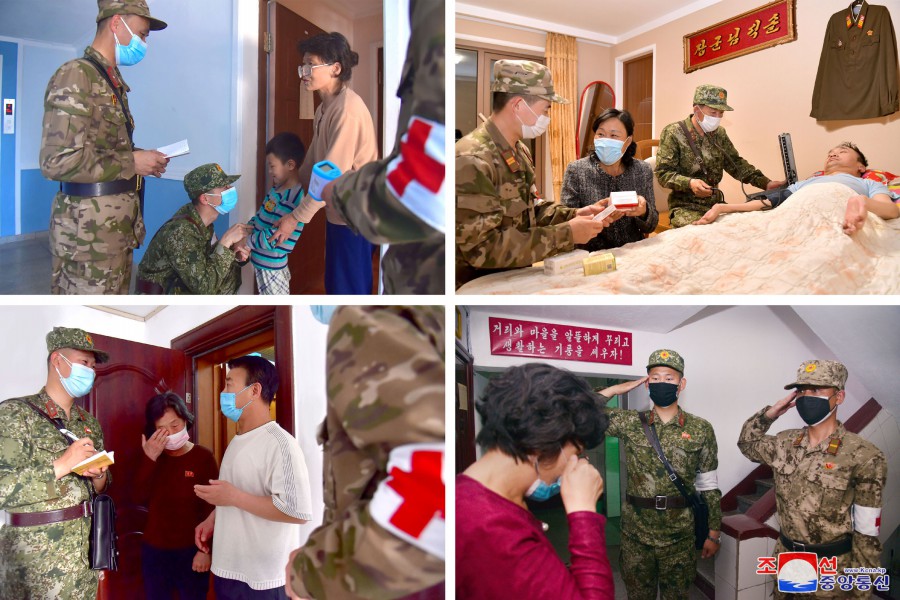
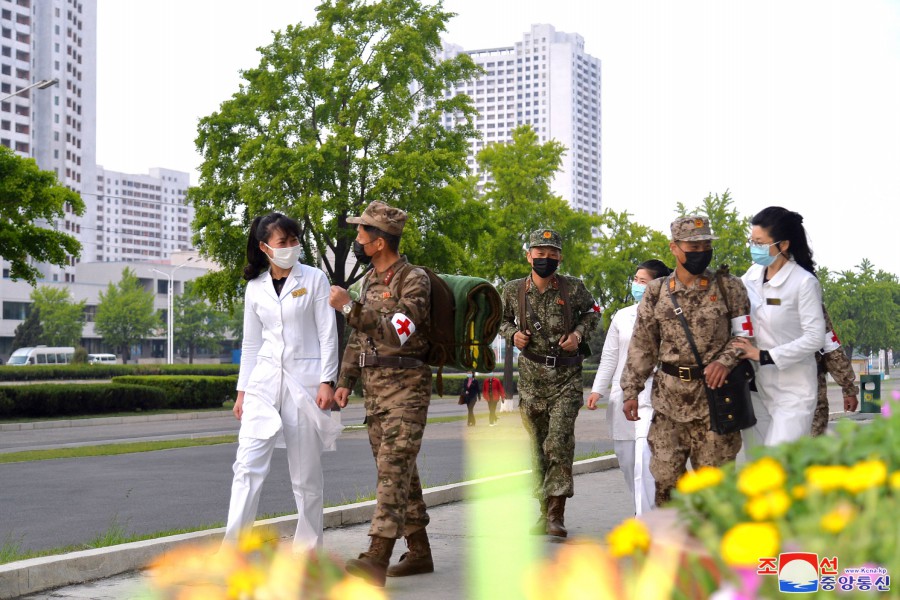
May 26, 2022
The number of new cases of fever in North Korea continued to drop on Wednesday, per government data released on Wednesday. There were 271,810 total cases under treatment at 6 p.m. on Wednesday, a drop of 16 percent from the day prior.
New cases were reported as 105,500 on Wednesday, down nine percent.
While the emergency conditions continue inside North Korea, state TV has broadcast new propaganda posters produced by the Mansudae Art Studio. This one asks citizens if they are following the emergency quarantine rules.
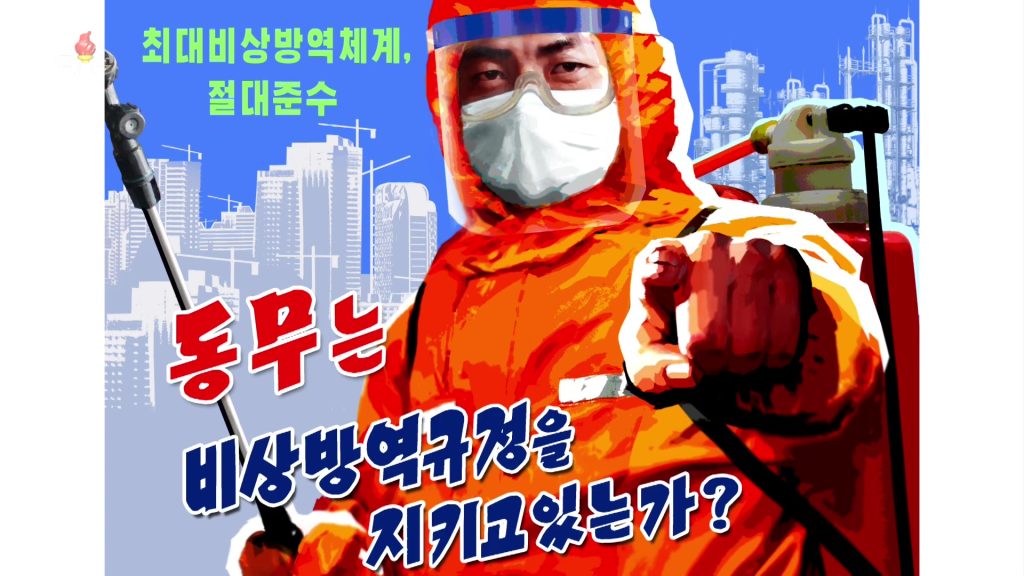
Across the nation, the number of new and existing cases dropped in every province and city. The epidemic is worse in Kaesong where 3.76 percent of the city’s population was sickened as of Wednesday at 6 p.m. In Pyongyang, cases continue to decline and make up 1.15 percent of the population as of Wednesday evening.
Emergency epidemic control restrictions remain in place.
For more context on the extraordinary reporting by North Korean state media, read a comprehensive analysis by Stimson Center Nonresident Fellow Rachel Minyoung Lee. She writes that the level of detail provided is remarkable for North Korea and underscores the severity of the situation and the leadership’s alarm.
Also on 38 North, William Brown writes North Korean imports of goods from China jumped in April, just before the fever outbreak began. Cross-border trade has been suggested as a possible entry point for COVID-19, although North Korean authorities have not named a suspected source.
May 25, 2022
The number of new cases of fever in North Korea continued to drop on Tuesday as total case numbers also continued their downward trend, according to government data released on Wednesday. There were 323,330 total cases under treatment at 6 p.m. on Tuesday, a drop of 19 percent on the day.
There were 115,970 new cases on Tuesday, down 14 percent on the day but evidence that the epidemic continues to spread even though it appears to be gradually under control, according to state data. As of Tuesday, over three million North Koreans have shown symptoms since the outbreak began in late April. That’s 12 percent of the population, according to official figures.
State television on Wednesday broadcast images of workers delivery food to residents in Pyongyang and rural health workers visiting small villages.
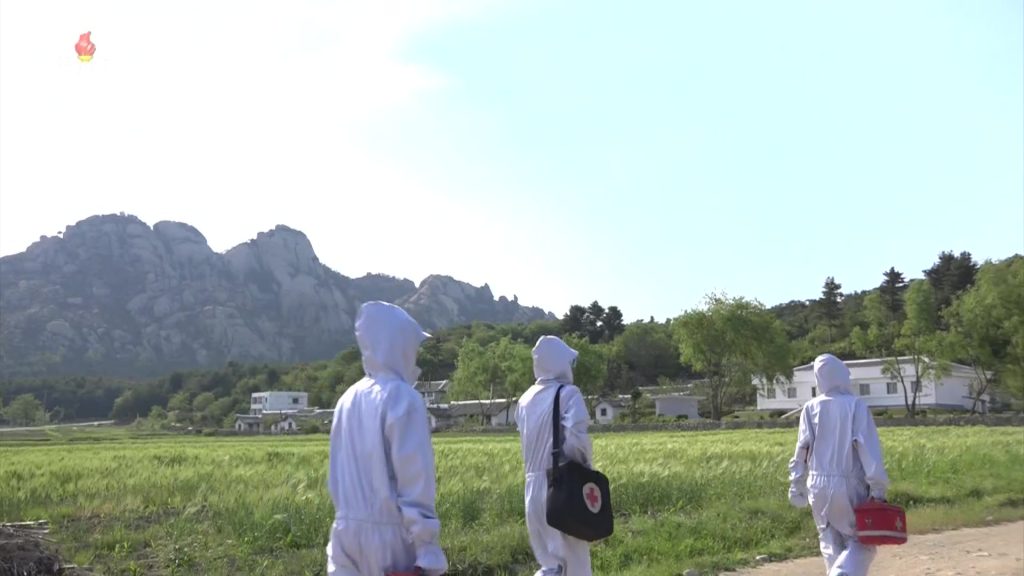
May 24, 2022
North Korea registered its fourth straight daily drop in the number of new cases of fever on Monday and the first day with no reported deaths since the current epidemic was disclosed almost two weeks ago.
There were 134,519 new cases in the 24 hours to 6 p.m. on Monday and 213,680 people recovered, the Rodong Sinmun newspaper reported on Tuesday morning. In an editorial in the same edition, the newspaper likened the health crisis to a warlike condition and called on citizens to rally around the Workers’ Party Central Committee to defeat it.
As of Monday evening, 400,000 North Koreans remain “under treatment” for fever with 2.5m recovered. Together, that means about 11 percent of the nation has shown symptoms since the outbreak began in late April. North Korea has stopped disclosing the number of COVID-19 tests conducted each day and their results.
State media reported over a million medical workers, teachers and students have been mobilized as part of the state response, which has also seen army medics working in pharmacies.
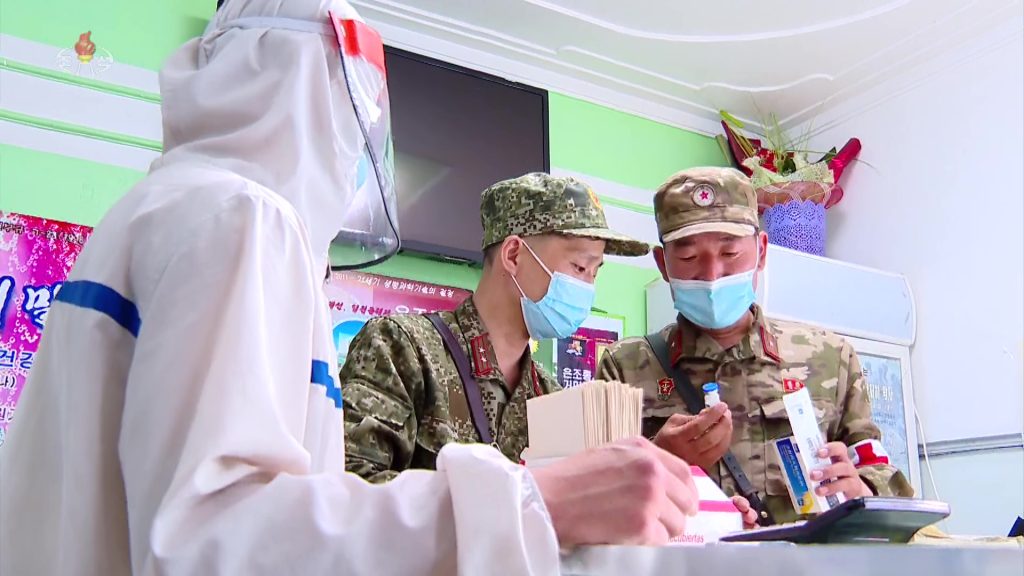
State TV showed images of what it said was increased production at factories manufacturing traditional Korean medicine.
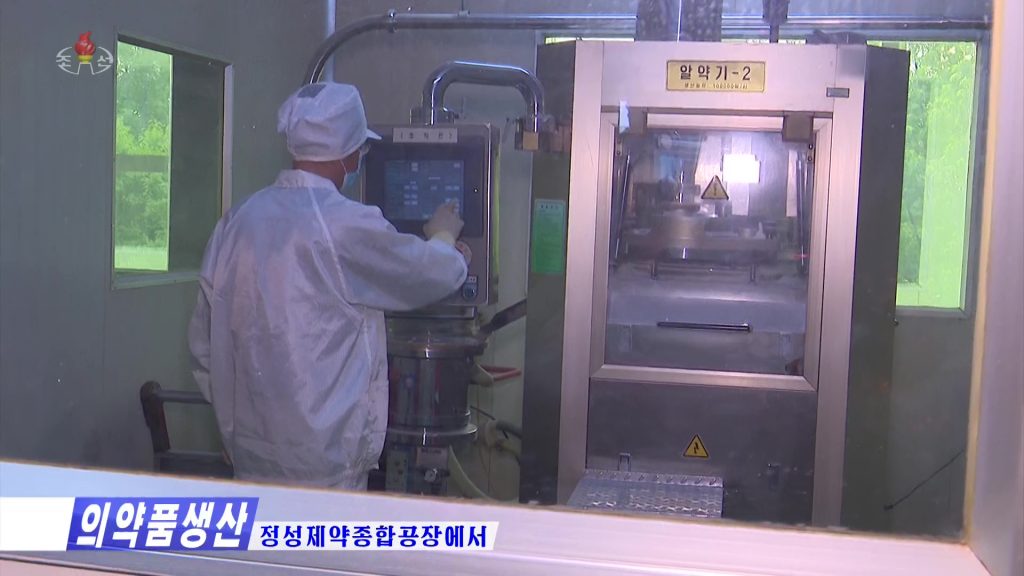
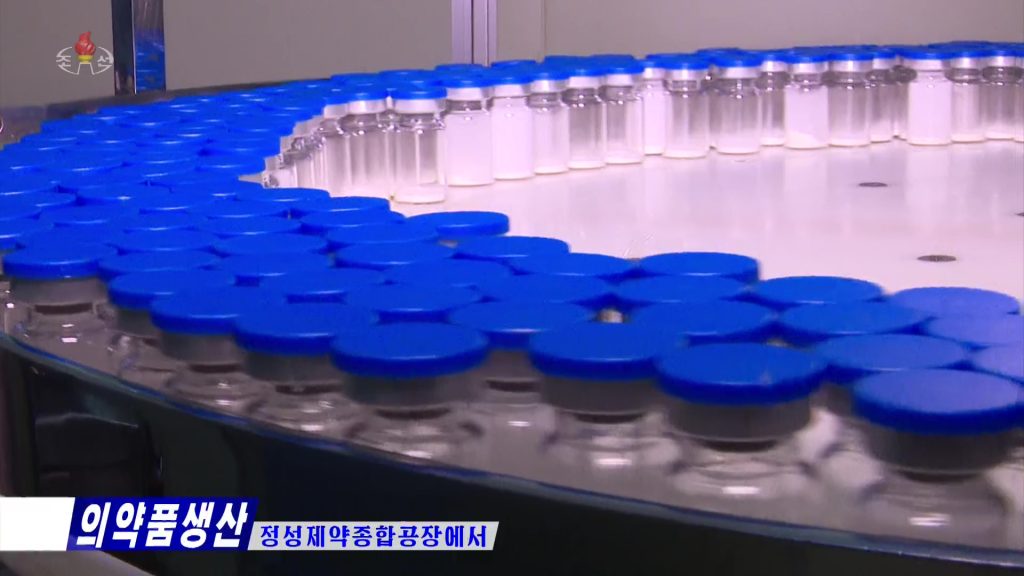
Across the nation, cases fell in all regions except Rason in the far northeast of the country, and Kaesong, which borders South Korea. Both those areas have been heavily affected by the outbreak and while cases have fallen rapidly in Pyongyang, according to government data, they have not abated as dramatically in those two regions.
Kaesong now leads the nation with 5.2 percent of its population currently under treatment. In Rason cases account for 4.7 percent of its population; and in Nampho, 4.4 percent. In contrast, active cases now affect just 1.6 percent of people in Pyongyang.
May 23, 2022
For the third day in a row, the number of people in North Korea currently under treatment for feverish symptoms (presumably COVID-19) dropped on Sunday, according to government figures released on Monday. There are currently 479,400 people in treatment out of a total of 2.8m who have experienced sickness. That represents 11 percent of the population.
The number of new cases is also falling fast and was 167,650 on Sunday. A total of 68 people have reportedly died. That number has been increasing by a single death for each of the last three days.
The data suggests that the government’s lockdown and restrictions on movement are having a positive effect. On Sunday, state television broadcast images of empty streets in several cities across the nation including Wonsan on the east coast and Sinuiju on the Chinese border.
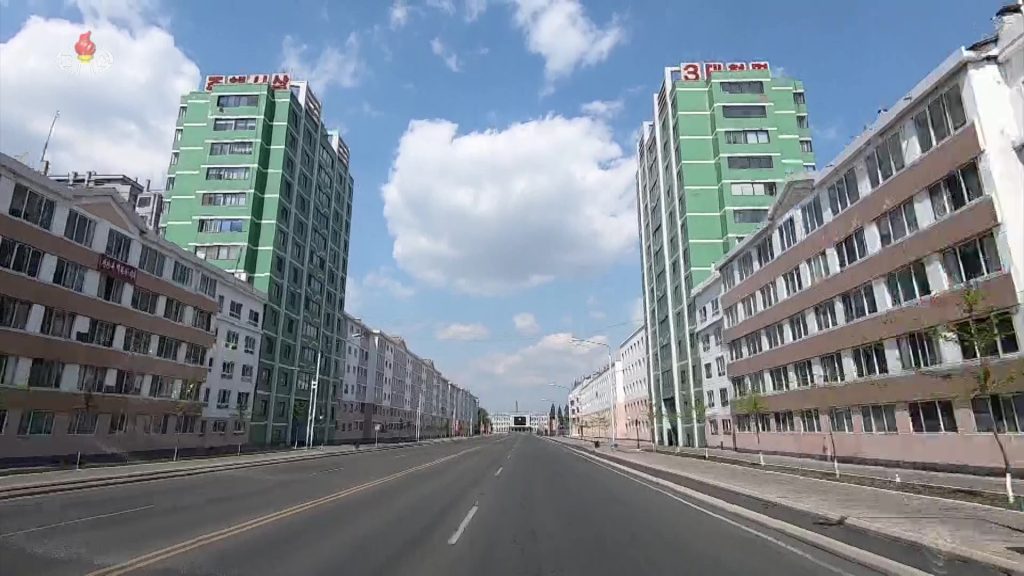
At the same time, thousands of people gathered in the streets of Pyongyang on Sunday, May 22, to attend the state funeral of retired Korean People’s Army (KPA) Marshal Hyon Chol Hae. Almost everyone wore masks except Kim Jong Un and the honor guard members.
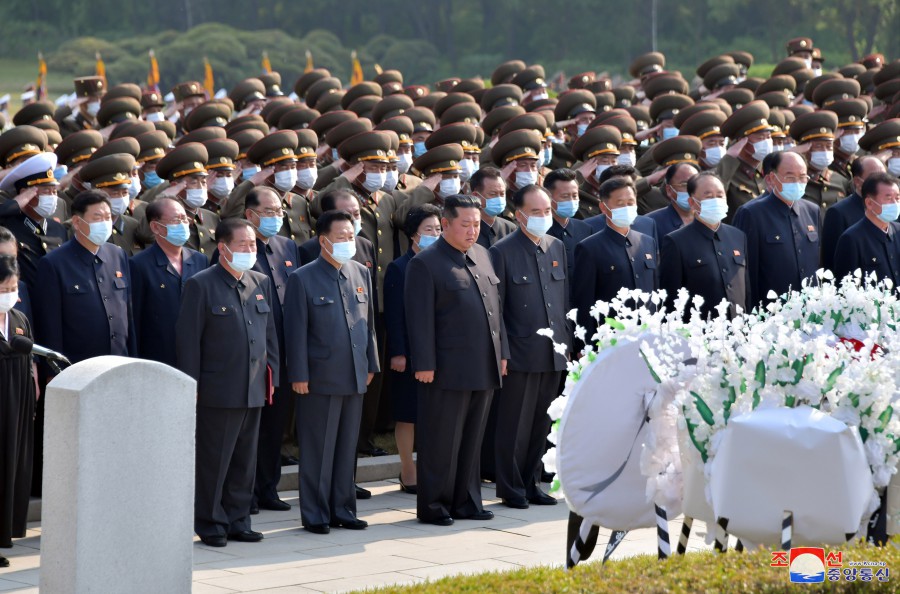
Active cases have in Pyongyang halved between May 19 and 21 to just over 100,000 people or about three percent of the city’s population. Cases are also falling in neighboring Nampho but continue to rise slowly in the southern city of Kaesong.
The case surge in South Pyongan province, which is to the north of Pyongyang, appears to have ended and cases have dropped for the last two days, according to the data. Cases rose in South Hwanghae, North Hamgyong and Ryanggang provinces and Kaesong city.
May 21, 2022
For the first time since North Korea began providing outbreak data a week ago, the total number of active cases fell on May 20. State media reports 692,480 people were under treatment as of 6 p.m. on Friday down from more than 60,000 on the day. The government reported 219,030 new cases of fever on Friday and a single new death. In total, 2.5 million North Korean have been sickened by the outbreak, which is about 9.5 percent of the population.
On Saturday, state television broadcasted video of Kim Jong Un attending a late-night politburo meeting to discuss the current situation and the bier of Hyon Chol Hae, a North Korean Army marshall who died earlier this week. In contrast to earlier in the week, Kim was not wearing a mask in the TV images but others were.
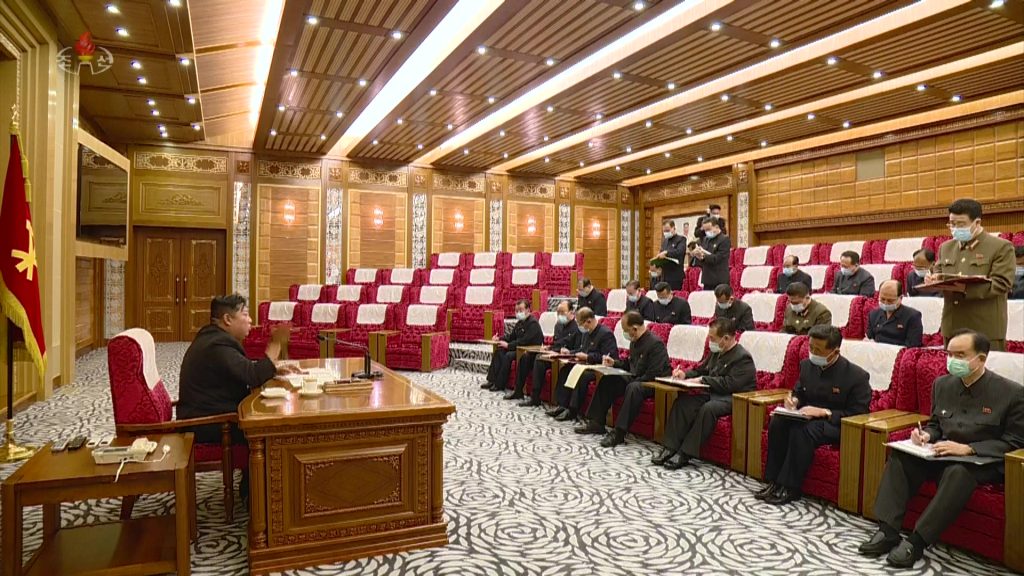
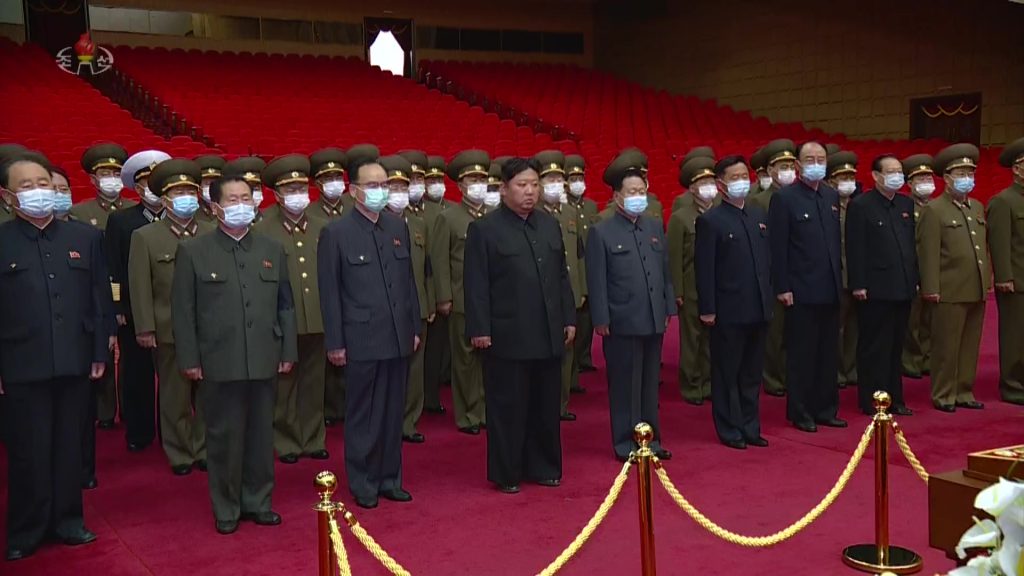
Cases continued to fall in Pyongyang, but the outbreaks in the country's central provinces showed no sign of slowing down, according to provincial-level data. The local data lags the national figures by a day so doesn't reflect the drop seen on Friday.
In North Hwanghae province, which is to the south of Pyongyang, 3.1 percent of the population was under treatment on Thursday. The rate was 2.8 percent in neighboring Kangwon and 2.5 percent in South Pyongan province, which borders Pyongyang to the north. Rates continue to be high in Kaesong and Rason but nowhere is as bad as Nampho, where nine percent of people are currently under treatment, according to the government figures.
May 20, 2022
North Korea saw 263,370 new cases of fever in the 24 hours to 6 p.m. on Thursday, state media reported Friday morning. That’s equivalent to the number of new cases the previous day. Two people died and 248,720 recovered, according to the government figures. Across the nation, just over three-quarters of a million people are being treated and 65 deaths have been attributed to the outbreak. North Korea is only believed to have tested a small fraction for COVID-19.
On Thursday, state media reported more on the medical response to the epidemic and provided an insight into what the sick can expect. Regional treatment centers have been formed and more isolation wards created but the technological response appears to extend to more thermometers, unspecified injections and traditional medicine. State media also reported thousands of tons of salt were transported to Pyongyang to make antiseptic solution.
It also said work was underway to identify failings in the epidemic prevention measures so far. Consultations had begun to “immediately rectify” the “vulnerable points, vacuums, evils and defects revealed in epidemic prevention work.”
Cases continue to fall in Pyongyang, likely as a result of strict curbs on movement, but they did increase in neighboring Nampo.
Around 38,000 people are currently being treated in the province, which accounts for about nine percent of its population. The general rise in fever cases in the provinces at the center of the country continued on Wednesday, according to government provincial-level data, which runs a day behind the national data. In South Pyongan province, which is to the north of Pyongyang, cases have surged from 43,736 on Monday to 80,920 on Wednesday, but as a percentage of the provincial population, it remains relatively low at two percent.
Cases are also rising fast in South Hamgyong, which has seen a jump from 21,477 on Monday to 53,814 on Wednesday. The latter represents 1.5 percent of the provincial population. The sole death announced on Wednesday was in North Pyongan province.
On May 19, South Korea's National Intelligence Service told lawmakers that waterborne diseases, like measles and typhoid, had already been spreading and that the fever totals include those outbreaks. That hasn't been confirmed by North Korea.
May 19, 2022
The number of new fever cases has registered its first rise in three days, North Korean state media reported on Thursday. The country saw 262,270 new cases in the 24 hours to 6 p.m. KST on May 18 but only one death, according to the Rodong Sinmun newspaper. In total, just under two million North Koreans, or nearly eight percent of the population have been hit by the fever outbreak with 741,000 still being treated. Total deaths stand at 63.
Current cases are falling in Pyongyang but starting to rise across the country, according to the latest provincial data released by the North Korean government. In the 24 hours to 6 p.m. on May 17, Pyongyang was overtaken by neighboring Nampho as the area with the greatest number of active cases at 7.7 percent of the population versus 6.8 percent in the capital. Cases also fell in Rason in the northeast of the country from 5.2 to 4.7 percent of the population
Elsewhere, most provinces saw infection rates rise. The largest increases were seen in South Pyongan and South Hamgyong provinces, although with only four days of provincial data having been released by the government, it’s unclear whether any of these changes are down to reporting problems and delays or the underlying epidemic.
Korean Central Television broadcast more images of quarantine and health workers in Pyongyang.
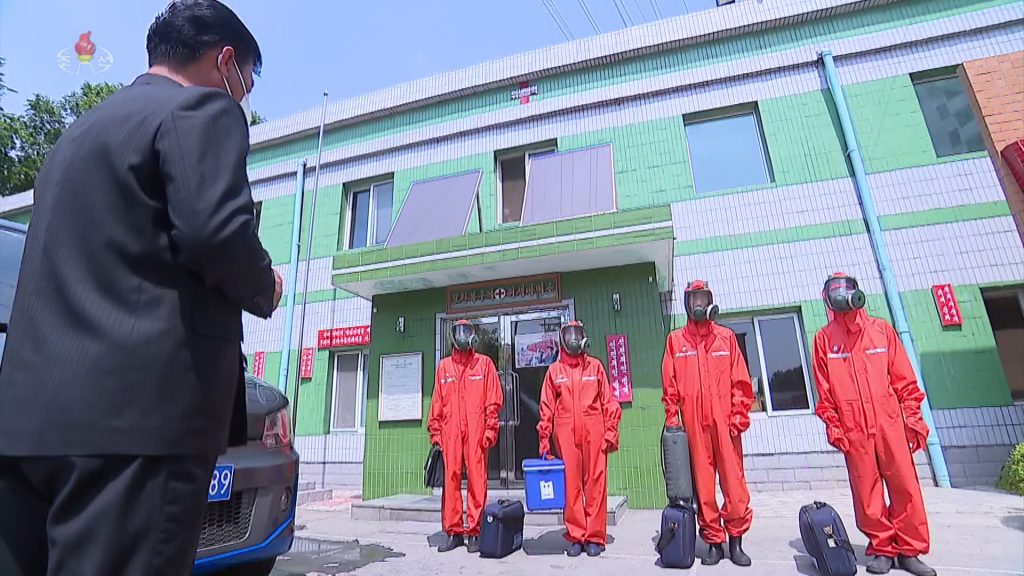
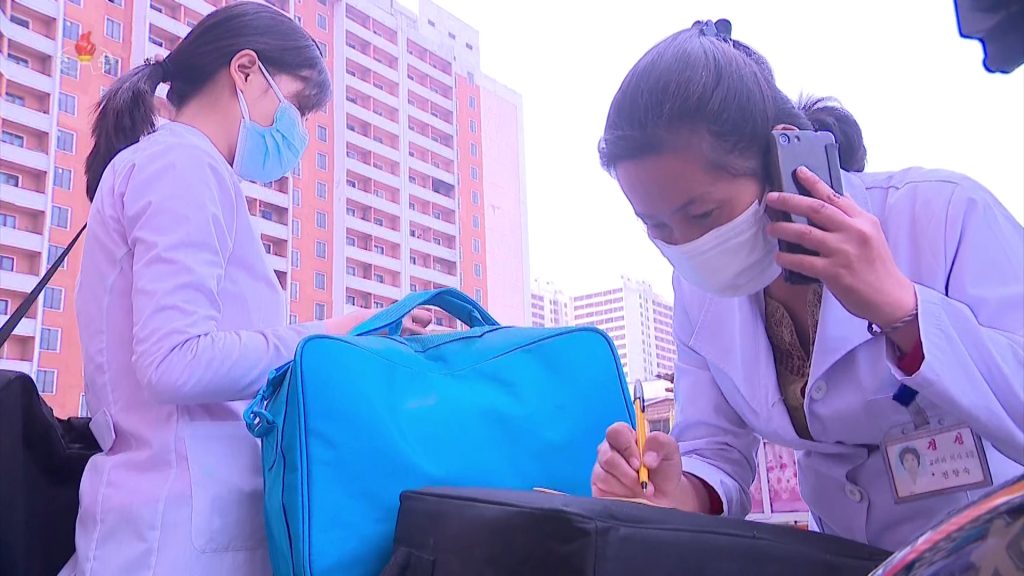
May 18, 2022
North Korean state media reported 232,880 new cases of fever diagnosed in the 24 hours to 6 p.m. KST on May 17. That’s the second day in a row that new cases have dropped, although with only six days of data is it too early to draw conclusions about what this means. An additional six deaths were reported taking the nationwide total to 62 since the outbreak began. There are currently 691,170 active cases nationwide and just over one million people have recovered. In total, 1.7 million people, or 6.7 percent of the population, have experienced symptoms to date.
Pyongyang remains the hotspot of the outbreak with 269,000 active cases, which is about 7.5 percent of the city’s population. On Wednesday, North Korean state television broadcast images of empty streets and parts of the city cordoned off with “No Entry” signs and guards.
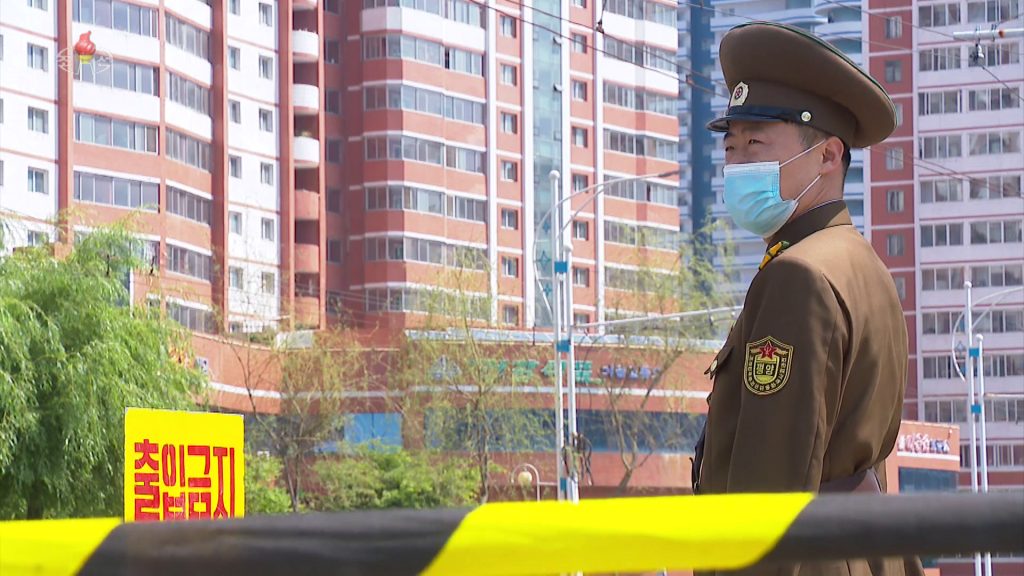
It also showed images of health workers visiting people in their homes and workers in full protective equipment carrying bags of gochujang paste, presumably to deliver to homes.
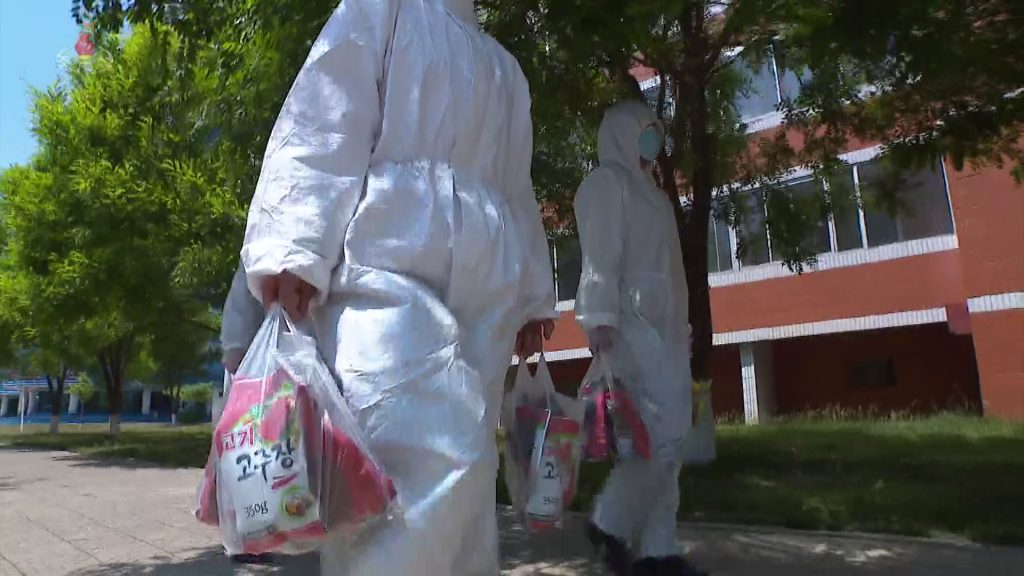
Nearby Nampho has the second-highest level of cases, at 6.7 percent of the population, followed by Rason and Kaesong.
The death toll rose by six people on Tuesday to 62 with an additional death in each age group except the over 60s, which remained the same. Deaths among the under 20s now equal those among the over 60s in this outbreak.
On 38 North's affiliated blog, North Korean Economy Watch, Benjamin Katzeff Silberstein looks at the government's numbers and argues they might tell us more about how the government perceives the outbreak than how many North Koreans have actually been infected with Covid-19.
May 17, 2022
North Korean state media reported 269,510 new cases of fever diagnosed in the 24 hours to 6 p.m. KST on May 16 to 6 p.m. KST on May 16. An additional eight deaths were reported taking the nationwide total to 50 since the outbreak began. The country currently has 663,910 active cases and 819,090 people have recovered. Together, that means 1.5 million people, or 5.7 percent of the population, have experienced symptoms.
Provincial data reported on Korean Central Television indicates the fever outbreak is hitting North Korea’s main cities the hardest. In Pyongyang there were 240,459 people being treated as of May 15, accounting for roughly seven percent of the city’s population. Cases in Nampho were equally high at seven percent and in Rason and Kaesong active cases accounted for about 4.5 percent of the populations.
Of the 50 deaths reported to date, about a third have been among North Koreans aged 61 or older. By age group, infants and children up to 10 years old have been second hardest hit with eight deaths, according to state data.
